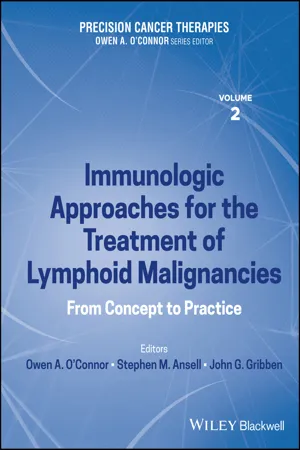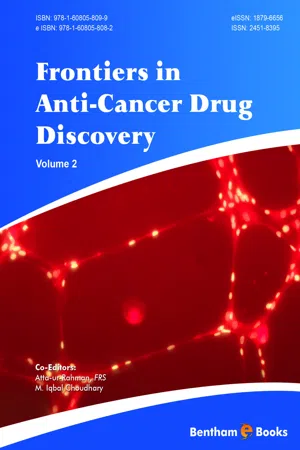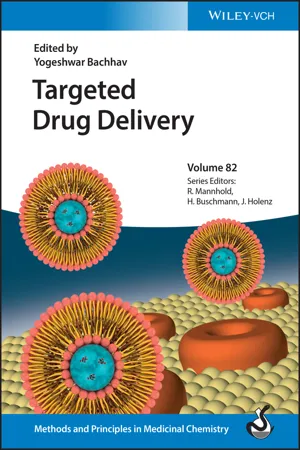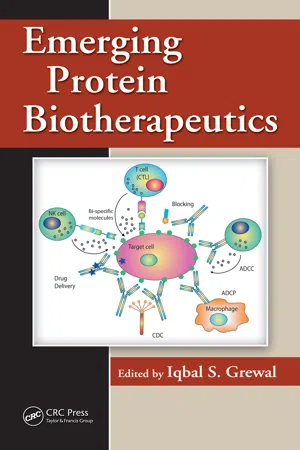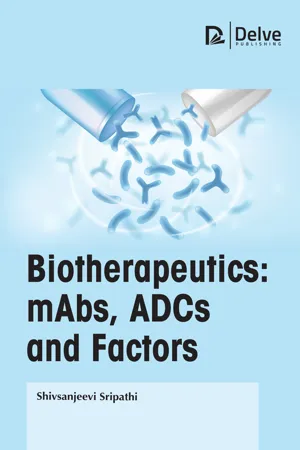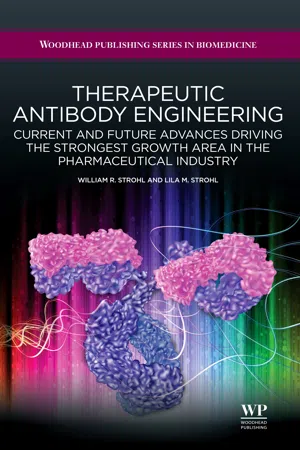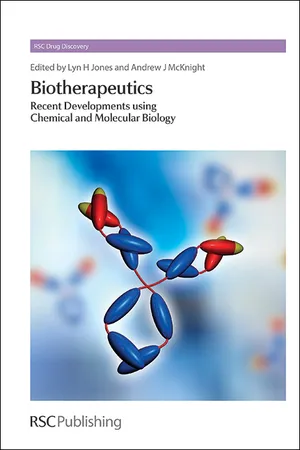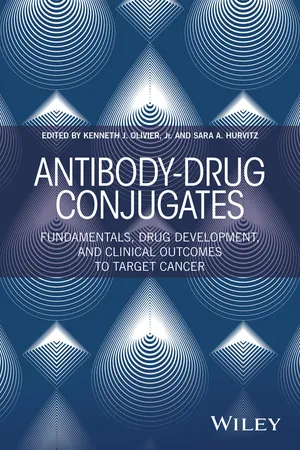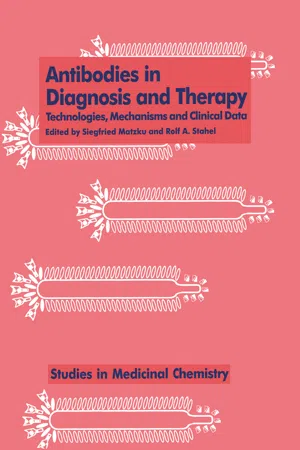Biological Sciences
Antibody Drug Conjugate
An Antibody Drug Conjugate (ADC) is a type of targeted cancer therapy that combines an antibody with a cytotoxic drug. The antibody specifically targets cancer cells, delivering the drug directly to the tumor cells while minimizing damage to healthy cells. This approach can enhance the effectiveness of chemotherapy and reduce side effects.
Written by Perlego with AI-assistance
Related key terms
1 of 5
11 Key excerpts on "Antibody Drug Conjugate"
- eBook - PDF
Precision Cancer Therapies, Immunologic Approaches for the Treatment of Lymphoid Malignancies
From Concept to Practice
- Owen A. O'Connor, Stephen M. Ansell, John G. Gribben(Authors)
- 2024(Publication Date)
- Wiley-Blackwell(Publisher)
73 Section III Antibody Drug Conjugates (ADC) 75 Precision Cancer Therapies: Immunologic Approaches for the Treatment of Lymphoid Malignancies: From Concept to Practice, Volume 2, First Edition. Edited by Owen A. O’Connor, Stephen M. Ansell, and John G. Gribben. © 2024 John Wiley & Sons Ltd. Published 2024 by John Wiley & Sons Ltd. 6 Principles of Antibody Drug Development Eric L. Sievers Chief Medical Officer, BioAtla, Inc., San Diego, CA, USA Take Home Messages ● ADCs are a rapidly growing class of oncology therapeutics, which have three core components: an antibody that binds to a tumor-specific antigen, a cytotoxic payload, and a connecting linker. Each of these components can vary bet- ween different ADCs and each can influence their pharma- cological profile. ● The overarching principle is simple: attaching a cytotoxic drug to an antibody with specificity for tumor antigens kills the tumor cell and limits adverse effects on non-target tissue. ● The mechanism of action of ADCs is complex and multi- factorial. After binding to tumors, the receptor-ADC com- plex is usually internalized, the linker is cleaved, and the cytotoxic drug is released to induce cytotoxic effects through various mechanisms of action such as binding to DNA or interacting with tubulin. As of today, a total of 11 ADCs are FDA-approved for the treatment of cancer, including 5 specifically for lymphoid malignancies (ben- tuximab vedotin, inotuzumab ozogamicin, polatuzumab vedotin, belantamab mafodotin, and loncastuximab tesirine). Introduction Antibody-drug conjugates (ADCs) are a rapidly growing class of oncology therapeutics comprising monoclonal antibodies (mAbs) linked to potent cytotoxic agents. The overarching principle is elegantly simple: employ a mAb with specificity for a target antigen expressed by tumor tissue to selectively deliver a cytotoxic agent to ablate cancer cells. - Atta-ur-Rahman, M. Iqbal Choudhary(Authors)
- 0(Publication Date)
- Bentham Science Publishers(Publisher)
Antibody-Drug Conjugates as Therapeutic Agents in Oncology: Overview And Perspectives Milos Dokmanovic , Mohammed K. ElZarrad , Dianne S. Hirsch ,Wen J. Wu*Laboratory of Molecular Oncology, Division of Monoclonal Antibodies, Office of Biotechnology Products, Office of Pharmaceutical Science, Center for Drug Evaluation and Research, U.S. Food and Drug Administration, Bethesda, Maryland, USAAbstract
Antibody-drug conjugates (ADCs) are an emerging class of therapeutics that are generated by covalent attachment of cytotoxic agents to monoclonal antibodies via linkers. It is generally believed that following antibody binding to the antigen and ADC internalization, release of toxic payload would produce cytotoxic effects in tumor cells in relatively selective manner. The clinical development of ADCs was not feasible until several critical prior developments took place, including development of recombinant therapeutic monoclonal antibody production, advancement of linker technology, and discovery of potent cytotoxic agents.In this book chapter, we will briefly introduce the history of ADC development and focus on the development and mechanisms of action of ADCs in oncological indications. In addition to covering present ADC therapies in clinical trials we will also offer possible future directions for ADC therapies, such as development of antibodies against new therapeutic targets, use of novel antibody and non-antibody-based platforms for the ADC development, use of novel linker designs for ADC generation, as well as development of novel payloads for antibody-based conjugates. As these development trends continue, future potential of ADC therapies to address the needs in oncology indications will be explored. Note that the information presented in this article represents publically available information. Any opinions expressed reflect the views of the authors and do not represent the policy of the U.S. Food and Drug Administration.- eBook - ePub
- Yogeshwar Bachhav, Raimund Mannhold, Helmut Buschmann, Jörg Holenz(Authors)
- 2022(Publication Date)
- Wiley-VCH(Publisher)
5 Antibody–Drug Conjugates: Development and Applications Rajesh Pradhan 1, Meghna Pandey 1, Siddhanth Hejmady 1, Rajeev Taliyan 1, Gautam Singhvi 1, Sunil K. Dubey 1, 2 and Sachin Dubey 3 1 Birla Institute of Technology and Science, Department of Pharmacy, Pilani Campus, Pilani, Rajasthan, 333 031, India 2 Emami Ltd., R&D Healthcare Division, 13, BT Road, Belgharia, Kolkata, 700 056, India 3 Ichnos Sciences SA, Chemin de la Combeta 5, La Chaux‐de‐Fonds, 2300, Switzerland 5.1 Introduction The focus of drug discovery has shifted from synthetic drugs to biologics. For the past few years, the emergenc e of biologics has revolutionized the sector of medical care [1]. Biologics have significant advantages over synthetic drugs, especially the targeted delivery that leads to faster onset of action and reduced incidence of adverse effects. The United States Food and Drug Administration (USFDA) approved 48 drugs in 2019, out of which 10 are biologics [2]. Out of the 10 approved biologics, 3 of them are antibody–drug conjugate s (ADC s). Overall, USFDA has approved seven ADCs for the treatment of cancer until now with the first approval in the 1990s. There is also a prediction that the number of ADC approvals will increase day by day considering that, more than 100 ADCs are in the clinical investigation phase [3]. Initially, the monoclonal antibodies were utilized for treating the disease, and over the years, the concept of ADCs was introduced with the help of recombinant technology. The ADC can improve the potency and the effectiveness of the treatment. It has three main components – (i) the recombinant monoclonal antibody that is covalently bound to (ii) the drug molecule or the payload with the help (iii) of synthetic linkers [4]. In the early 1900s, the German physician Paul Ehrlich coined the term “magic bullets” [5] - eBook - PDF
- Iqbal S. Grewal(Author)
- 2009(Publication Date)
- CRC Press(Publisher)
325 16 Recent Advancements in the Use of Antibody– Drug Conjugates for Cancer Therapy Peter D. Senter and Dennis R. Benjamin KEY WORDS: monoclonal antibody, drug delivery, conjugate ABSTRACT A great deal of interest surrounds the use of monoclonal antibodies (mAbs) for the selective delivery of cytotoxic drugs to tumors. The premise behind this approach is that by targeting drugs selectively to tumors, it should be possible not only to improve therapeutic efficacy, but also to minimize the toxic side effects on noncancerous tissues. Early work in this field surrounded the use of antibody–drug conjugates (ADCs) comprising clinically approved drugs and mAbs that were highly immu-nogenic when administered in humans. The results of such studies have prompted investigation toward understanding the key parameters affecting activity and toler-ability. These include the selection of the antigen target, the use of nonimmunogenic CONTENTS Abstract .................................................................................................................. 325 Introduction ............................................................................................................ 326 Optimization of ADC Drug and Linker Components ............................................ 326 Conventional Drugs ........................................................................................... 326 Highly Potent Drugs .......................................................................................... 328 Linker Technology ............................................................................................ 330 Optimization of Conjugation Technology .............................................................. 334 Methods for Drug Attachment .......................................................................... 334 Drug to Antibody Ratios ................................................................................... - eBook - PDF
- Shivsanjeevi Sripathi(Author)
- 2023(Publication Date)
- Delve Publishing(Publisher)
the targeting of cancer cells and actively dividing healthy cells attributed to the ubiquitous side-effects. Research is uncovering the potential of ADCs to amalgamate the ability of antibodies to facilitate the selective binding and the property of cytotoxic drugs to kill malignant cells (Baah S, Laws M, Rahman KM, 2021). Biotherapeutics: mAbs, ADCs and Factors 88 Figure 1 below is illustrative of ADC development across time (Baah S, Laws M, Rahman KM, 2021: © 2021 by the authors. Licensee MDPI, Basel, Switzerland. This article is an open access article distributed under the terms and conditions of the Creative Commons Attribution (CC BY) license: https://creativecommons.org/licenses/by/4.0/): Antibody Drug Conjugates (ADCs): The Foundation 89 3.3 STRUCTURE OF ADCS ADCs are composed of a monoclonal antibody, a cytotoxic drug (cytotoxic payload or warhead) and a linker that joins these two components. While mAbs are demonstrative of a slew of mechanisms ranging from immune checkpoint inhibition to complement-dependent cell-mediated cytotoxicity (CDCC) to antibody-dependent cell-mediated cytotoxicity (ADCC) to neutralization of receptor(s) and targeted signaling, ADCs entail internalization via a target receptor to deliver the cytotoxic payload inside the malignant cell (Hafeez, U., Parakh, S., Gan, H. K., & Scott, A. M, 2020; Ponziani et al, 2020; Baah S, Laws M, Rahman KM, 2021). Figure 2 below is illustrative of an ADC (Ponziani, S., Di Vittorio, G., Pitari, G., Cimini, A. M., Ardini, M., Gentile, R., Iacobelli, S., Sala, G., Capone, E., Flavell, D. J., Ippoliti, R., & Giansanti, F (2020): © 2020 by the authors. Licensee MDPI, Basel, Switzerland. This article is an open access article distributed under the terms and conditions of the Creative Commons Attribution (CC BY) license: http://creativecommons.org/licenses/by/4.0/): A high copy number is warranted of the antigen that is to be targeted (>10 5 /cell). - eBook - ePub
Therapeutic Antibody Engineering
Current and Future Advances Driving the Strongest Growth Area in the Pharmaceutical Industry
- William R Strohl, Lila M Strohl(Authors)
- 2012(Publication Date)
- Woodhead Publishing(Publisher)
15Antibody-drug conjugates
Abstract:
Various methods have been used to improve the ability of antibodies to kill cells, perhaps the most complex of which are antibody-drug conjugates (ADCs). ADCs require an antibody or targeting moiety, a linker, and a toxic chemical. The antibody can be an IgG, an antibody fragment, or even a nonantibody binding protein. The linker is typically either a synthetic chemical linker or a peptide linker, and the toxic chemical can be either a cytotoxic natural product derivative such as monomethyl auristatin, a peptide or protein toxin usually derived from bacteria or plants, or a radionuclide. While in the past, ADCs were not significant drugs, recent improvements have made the newer generation of ADCs much more likely to succeed as therapeutics. Radionuclide-based conjugates also can be used for a variety of imaging modalities as diagnostics.Keywords antibody-drug conjugates (ADCs) chemical warheads (payload) linker natural products doxorubicin calicheamicin maytansanoids monomethyl auristatins duocarmycins bystander effect immunotoxins PE38 radioimmunoconjugates PET SPECT imaging15.1 Introduction to antibody-drug conjugates
Antibody-drug conjugates (ADCs) are defined as antibodies to which other molecules are bound through a chemical linker. The term “conjugate” differentiates these modified antibody forms from peptide fusions that may be genetically fused to N- or C-termini of either the light or heavy chains of the antibody. The general principle of ADCs is to use the antibody to target a particular cell population, thereby carrying the conjugated molecule to that targeted cell population so that it can exert most, if not all, of its pharmacological activity upon just that population. In the most common case of ADCs, this is exemplified by antibody cell targeting, internalization by the cells (generally cancerous), and payload release to expose the highly potent cytotoxic drugs to the tumor for toxin-mediated tumor cell killing (Lambert, 2005 ; Ricart and Tolcher, 2007 ; Chari, 2008 ; Carter and Senter, 2008 ; Beck et al., 2010 ). Thus far, most anti-tumor drugs need to be dosed at, or very near, their maximum tolerated dose in order to achieve the desired therapeutic efficacy (Chari, 2008 - eBook - ePub
- Yuliang Zhao, Youqing Shen(Authors)
- 2016(Publication Date)
- Wiley-VCH(Publisher)
Figure 6.1 ).Antibody–drug conjugate (ADC) timeline [25].Figure 6.16.2 History of ADCs
6.2.1 Concept of ADCs
The original concept of ADCs can date back to 100 years ago, when a German scientist, Paul Ehrlich put forward the idea of “Magic Bullets” [33, 34]. He proposed that some targeting agents could act as guider to deliver the cytotoxic drugs only to the targeted organism. About 50 years later, the first sample of “Magic Bullets” was reported by Bernard and coworkers, in which methotrexate, a kind of early used antitumor drug, was linked to γ-globulins, which can target leukemia cells [35]. At the early research stage of ADCs, the connections between drugs and targeting agents were usually noncovalent linkages [36–38] or inefficient covalent linkers [39, 40]. Besides, the most frequently used targeting agents were polyclonal antibodies with less specificity than monoclonal antibodies until 1975, when Kohler and Milstein developed the hybridoma technology enabling the production of a large number of monoclonal antibodies to specific antigens [41]. The hybridoma technique is briefly described as the fusion of antigen-stimulated B lymphocytes that produce monoclonal antibodies with mouse myeloma cells to form hybrid cell lines. The success of monoclonal antibody production led to the first human clinical trial of ADC, where vindesine, a kind of antimitotic vinca alkaloid, was linked to an anti-CEA antibody [42]. Unfortunately, the foreign murine antibody usually resulted in a rapid clearance from circulation. With the development of recombinant DNA technology [43], the amino acid sequences of antibody could be engineered in a humanized form by editing its gene sequences directly. From then on, humanized antibodies were widely used in the development of new ADCs. - eBook - PDF
Biotherapeutics
Recent Developments using Chemical and Molecular Biology
- Lyn Jones, Andrew J McKnight(Authors)
- 2013(Publication Date)
- Royal Society of Chemistry(Publisher)
CHAPTER 6 Recent Advances in Antibody– Drug Conjugates EDMUND I. GRAZIANI* AND L. NATHAN TUMEY Oncology Medicinal Chemistry, Pfizer Global Research, 445 Eastern Point Road, Groton CT 06340, USA *Email: [email protected] 6.1 Introduction While it has long been recognized that to extend the lives of cancer patients, effective treatments must eradicate tumors, especially those that cause meta-static disease, the means to achieve this end have proven limited. Traditional chemotherapeutic agents, while effective in eradicating tumors, generally have a narrow therapeutic index and can be poorly tolerated. 1,2 While efforts are underway to design new classes of small molecules that are more selective for protein targets implicated in aberrant cell types but down-regulated in healthy cells, 3 there remain significant challenges in achieving efficacy in heterogeneous populations of proliferating cells within tumors. 4 In contrast, cancer therapy with monoclonal antibodies (mAbs) has proven to be well tolerated and modestly efficacious in a number of tumor types, but this treatment is rarely curative. 5 The concept of an antibody–drug conjugate (ADC) in which a highly potent (but poorly tolerated) chemotherapeutic agent is covalently attached to a mAb would appear to bridge the best aspects of each modality. 6 That is, while bound to the antibody, the chemotherapeutic ‘‘payload’’ no longer circulates systemically and is therefore well tolerated by healthy cells. However, if the mAb targets an antigen that is selectively expressed in tumor cell types, and if RSC Drug Discovery Series No. 36 Biotherapeutics: Recent Developments using Chemical and Molecular Biology Edited by Lyn H. Jones and Andrew J. McKnight r The Royal Society of Chemistry 2013 Published by the Royal Society of Chemistry, www.rsc.org 145 - Marianna Torok(Author)
- 2022(Publication Date)
- Elsevier(Publisher)
Even after several years of extensive research in ADCs development and formulation, only a few have been approved. Different methodologies have been adopted to predict the stability of ADCs and to enhance their formulation. As the understanding of ADCs advances, the regulatory aspects, including quality control, are also improving. Furthermore, a thorough understanding of the physicochemical characteristics is required to accelerate the design of successful ADCs toward clinical applications. Moreover, improvement in site-specific conjugation for linker optimization with potent cytotoxic agents can provide greater insight into the involvement of various factors to ADC efficacy. A guided control on heterogeneity through enhancements in site-specific conjugation will expand safety and efficacy. Promisingly, several ADCs are progressively entering clinical pipelines with improved efficacy and reduced side effects. Numerous novel cytotoxic agents, linkers, and engineered antibodies are presently being investigated, which provide hope for improved future generation of ADCs with the potential for more effective cancer treatments.References
1 . Khongorzul P, Ling C.J, Khan F.U, Ihsan A.U, Zhang J. Antibody-Drug Conjugates: A Comprehensive Review .Mol. Cancer Res.2020;18(1):3–19.2 . Strebhardt K, Ullrich A. Paul Ehrlich's Magic Bullet Concept: 100 Years of Progress .Nat. Rev. Cancer. 2008;8(6):473–480.3 . Trail P.A, Willner D, Lasch S.J, Henderson A.J, Hofstead S, Casazza A.M, Firestone R.A, Hellström I, Hellström K.E. Cure of Xenografted Human Carcinomas by BR96-Doxorubicin Immunoconjugates .Science. 1993;261(5118):212–215.4 . Understanding the Immune System : How it Works .Science Education. U.S. Department of health and human services, National Institutes of Health, National Institute of Allergy and Infectious Diseases and National Cancer Institute; 2003. www.niaid.nih.gov/research/research-frontiers-immune-system- eBook - ePub
Antibody-Drug Conjugates
Fundamentals, Drug Development, and Clinical Outcomes to Target Cancer
- Kenneth J. Olivier, Sara A. Hurvitz, Kenneth J. Olivier, Jr., Sara A. Hurvitz(Authors)
- 2016(Publication Date)
- Wiley(Publisher)
In an attempt to increase antitumor activity of anticancer drugs, oncologists have evaluated several families of highly cytotoxic agents such as the potent tubulin-acting agents, maytansine and dolastatin 10, and highly active DNA-acting agents such as the duocarmycins (adozelesin, bizelesin). Unfortunately, clinical evaluation of such potent compounds failed to show any clinical benefit; such compounds lacked a sufficient therapeutic window to be useful in cancer treatment (see e.g., [73]). However, with the advent of nonimmunogenic monoclonal antibodies (engineered antibodies, or derived from transgenic organisms expressing human immunoglobulin genes), medicinal chemists had the possibility of being able to harness the great potency of these cytotoxic compounds by using the potential tumor selectivity of antibodies as vehicles to concentrate them at the tumor. The proof of concept for this approach has been achieved with the approval of two ADCs bearing highly potent tubulin-acting agents, brentuximab vedotin, which received accelerated approval by FDA in 2011 for treating Hodgkin’s lymphoma and acute large-cell lymphoma [51], and ado-trastuzumab emtansine that received full approval from FDA in 2013 for treating metastatic HER2-positive breast cancer [26, 74]. These approvals have re-invigorated research into ADCs within academic institutions as well as in the biopharmaceutical industry. With over 50 compounds in clinical testing at the time of writing, the prospects are exciting for ADCs to make a significant contribution to improving the therapeutic options for cancer patients, offering agents that have excellent antitumor activity while lacking the severe toxicities that are frequently associated with cytotoxic chemotherapy.Acknowledgment
I wish to thank Dr Daniel Tavares for providing excellent illustrations of antibodies and ADCs and Dr Ravi Chari and Dr Wayne Widdison for their skilled drawing of chemical structures for linkers and payloads. I thank C Bennett for skilled editorial review. I wish to dedicate this chapter in memory of my mentor (and Ph.D. supervisor), Dr Richard N. Perham. - eBook - ePub
- Matzku(Author)
- 2019(Publication Date)
- CRC Press(Publisher)
protein toxins which act by different mechanisms than chemotherapeutic drugs and to which tumor cells are not cross-resistant. An ideal carrier to increase the antitumor efficacy of cytotoxic agents and to avoid damage to normal tissues would specifically recognize the tumor cell and increase the local concentration of the drug at the tumor site. This concept of targeted cytotoxicity, which was first proposed by Ehrlich nearly a century ago (Ehrlich, 1956), can be best realized using antibodies as ligands that bind to antigens on the surface of tumor cells. The monoclonal antibody technique (Köhler and Milstein, 1975) has made it possible to produce large amounts of uniform antibody molecules which can be further engineered chemically (Werlen et al., 1995; Offord et al., 1992) or by recombinant DNA technology (Plückthun, 1992; Pack and Plückthun, 1992) to produce tailor-made targeting vehicles in quantities useful for human therapy. To date cytotoxic antibody conjugates have emerged as a novel promising group of antitumor agents and a great variety of cytotoxic agents have been linked to antibodies including chemotherapeutic drugs and toxins (Table 1). Some of these agents are extremely potent or exhibit unspecific cell binding activity so that they must be harnessed by a tumor selective targeting moiety, and cannot be used in free form (reviewed by Poznansky and Juliano, 1984; Engert and Thorpe, 1990). Therefore, the targeting moiety, e.g. an antibody directed towards a tumor-associated antigen, must be carefully examined by immunohistochemistry on tissue sections and evaluated in patients using immunoscintigraphy before controlled phase I studies are performed. Table 1 Toxins and drugs conjugated to antibodies Intact antibody molecules or recombinant and chemical fragments thereof as well as drugs and toxins, display a number of biological properties dictated by their normal functions
Index pages curate the most relevant extracts from our library of academic textbooks. They’ve been created using an in-house natural language model (NLM), each adding context and meaning to key research topics.
